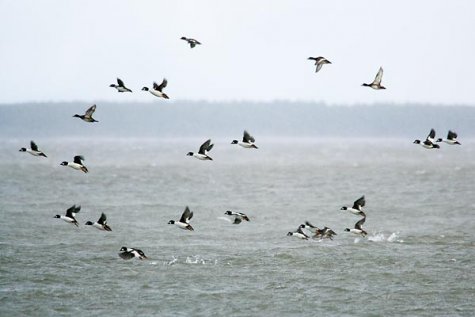Migrating goldeneyes encountered both at sea and inland waters
Photo: Arne Ader
Translation: Liis
Goldeneyes at sea. Hosby, Vormsi
Goldeneye Sõtkas Bucephala clangula
Migrant heralds of the beginning winter – long-tailed ducks, goldeneyes, whooper swans ... The passing migration of goldeneyes generally ends with November; winterers remain, they can be up to some twenty thousand.
Goldeneyes are medium-sized sturdy-looking diving ducks. Males are larger than females – the length of an adult male is less than half a metre and weight up to a kilo – while the female is a few centimetres shorter, and weight starts from half a kilo.
Goldeneye males already wear their springtime mating plumage; thus we will see them in June next year still looking exactly the same. The head, centre of the back and the outmost tail feathers are dark. The dark head plumage has a greenish metallic sheen, there is a round white patch beneath the bright yellow eye and the beak is black.
The female’s plumage is greyish, there is white in the neck ring, but in flight image only on the belly. In the dark brown head plumage we see the whitish eyes and black beak. The feet of both sexes have a yellow tint.
Diving ducks can forage quite far from the shore, on jellyfish (Scyphozoa), molluscs, aquatic insects; aquatic plants may be added to the diet at times.
Goldeneye observations: LINK









